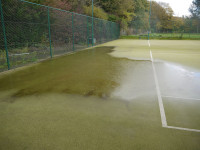Looks like we could be in for quite a harsh winter. As always advised, keep off frost affected turf; walking on it will cause the brittle leaves to break, thereby causing severe damage and, in some cases, death of the plant.
If in doubt, stay off.

Key Tasks for December

- grass growth will have slowed down, but certainly not stopped altogether, so you should continue to cut weekly, ensuring that you take no more than a third off in any one cut
- a cylinder mower may still be used, but it is more likely that a rotary mower will serve you better
- box clippings to avoid the spread of disease
- remove leaves and other debris as soon as possible – a rotary mower does a good job
Artificial courts
Keep surface clean with regular sweeping and brushing
Remove any algae and moss from surface. Sand filled systems require regular brushing to maintain manufacturer’s recommendations on sand levels and pile heights
American Fast Dry courts
- keep surface clean, rolling to consolidate surface
- levelling and brushing of fast dry materials, brushing to clean lines
Clay courts
- carry out regular sweeping and brushing to restore playing levels
- topdress any hollows or damaged areas
Tarmacadam
- carry out regular sweeping and brushing
- repair any hollows or damaged areas
With many clubs allowing and, indeed encouraging, play on their artificial surfaces through the winters months (when weather conditions allow) it is imperative that these courts are completely free from moss, algae, leaves or anything else that might pose a slip hazard.
Remember – that the sun is at its lowest in December and daylight hours are at their shortest, so any shade problems you have will be exacerbated. These areas tend to take longer to warm up and dry out which, in turn, may affect maintenance operations and playability.




December heralds the beginning of the meteorological winter and, consequently, inputs are at a minimum as cold soil temperatures slow metabolic activity of both microorganisms and plants to a crawl. As always, keeping an eye on weather forecasts is fundamental in being able to make decisions regarding inputs.
If cool humid conditions prevail, there may still be a risk of fungal diseases. Accordingly, timings of fungicide and plant stimulating nutrition, such as calcium, phosphite and silicon, can be made in suitable weather windows for spraying. It is worth noting that calcium and silicon, in particular, will aid the plant in resisting abiotic (environmental stress) in the form of frost, snow and harsh desiccating winds. Maximising the baseline level of soil and plant health going into harsh environmental conditions will greatly aid the quality of surfaces for longer.
Cold conditions require a move away from systemic fungicides, with iprodione generally being the active of choice for many.
Be aware that withdrawal of iprodione is pending and you will not have this tool in the locker the same time next year.
Where disease outbreaks have occurred, target dormant spores in the thatch with an application of fludioxonil; this should be done in-between disease outbreaks but not during. The reason for this is due to the fact that, during outbreaks, spores are not spores but rather active disease now going through its life cycle with the aim of creating more spores as its end goal. This tactic of applying fludioxonil will reduce the background population and minimise the severity of further outbreaks once weather conditions for disease proliferation occur.
Chlorothalonil is another contact active ingredient which can be employed at this time of year. Hopefully, a well thought out disease management plan is being employed where timings of non-pesticidal plant nutrition is factored around appropriate fungicide treatments, which pay attention to the correct rotation of the relevant fungicide groups of the active ingredients being chosen.
Avoiding back to back applications of the same groups is a core responsibility for adhering to best practice and managing pathogen resistance. The FRAC website has more details and Syngenta provide some good practical information of how their products can best fit into this important consideration.
Dew may still be heavy at times, contributing to the problem of leaf canopy humidity which, in turn, leads to the spread of fungal pathogens. Removal of dews is a core fundamental cultural control for turf managers in all situations and should remain so. However, dews can be reduced by the application of a dew dispersal agent which will act to stop them forming in the first instance. This adds another element into an integrated approach to disease management, particularly on any persistently damp days when dews re-form post brushing. The key here is to minimise the period of continual leaf blade wetness as much as possible.
An important point of note when using dew dispersants; for best efficacy and longevity, they MUST be applied to a dry leaf.
Another tactic in the integrated locker is penetrant wetting agents. We are all familiar with using wetting agents to help prevent against dry patch in the summer, where they either facilitate the ingress of rain and irrigation into the profile or spread and hold it once it is in there. The flip side of this is using penetrant wetting agents in the autumn and winter to facilitate the efficient passage of water away from the surface and through the profile towards drainage systems. This has two advantages; firstly, by moving water faster through heavier soils or thatchy surfaces prone to waterlogging, you help to maintain an appropriate air/water ratio in the soil. This helps to stop the microorganisms you have spent all summer promoting from drowning. The other factor is that beneficial mycorrhizae and saprotrophic (composting) fungi really don’t like to be waterlogged. If you keep getting thatch build up on waterlogged areas which you know are not overfed, it is probably because the soil system cycle designed to degrade the organic matter is breaking down each and every autumn and winter once it becomes waterlogged.
A further benefit from using a penetrant wetting agent is that the better water penetration from the surface also helps to reduce canopy humidity, and thus the risk of fungal disease.
Aeration is a key activity to maintain throughout the winter, in whatever way possible. Be careful not to drive over waterlogged or wet ground, or also disturb surfaces with holes which will not heal in good time. Little and often with star, slit and sarrel tines, whenever possible, is probably best, especially if you have already been able to aerate deeper in the autumn. Again, the aim is to maintain a health air/water ratio for the benefit of soil life and plants.
Please note: More information on diseases can be found here: https://www.pitchcare.com/useful/diseases.php
James Grundy – Senior Technical Manager
With some machines not currently being used, take the time to carry out an overhaul or send them away for a service.
- inspect and clean machinery before putting away for the winter
- replace worn and damaged parts as necessary
- empty fuel tanks as petrol will go stale over winter
- maintain a stock of consumables for your machinery
- secure machinery nightly with good storage facilities and strong locks
- record makes and models and take pictures of your equipment as additional reference
- don’t leave it to the last minute when servicing dealers will be very busy

Some of the other courses available are:
- Chainsaws - CS30 and CS31
- H&S Refresher Training on Combined Turf Care Equipment; Tractors and Trailers; All Mowers (Ride-on and Pedestrian)
- Machinery Courses on ATVs; Tractors: Brushcutters/Strimmers; Mowers (ride-on and Pedestrian)
- Pesticide Application (PA courses)
- Stem Injection of Invasive Species (Japanese Knotweed etc.)
- Basic Trees Survey and Inspection
More details about all the courses can be found on our new Grounds Training website, or you can email Chris Johnson for information.
Other Key Tasks
- repair and maintain fence lines
- cut back any hedges and trees and prune shrubs
- take down and store all tennis equipment, ensuring that it is clean and dry before doing so
- repair/update equipment as necessary
Current topics of discussion on the Pitchcare Forum:


